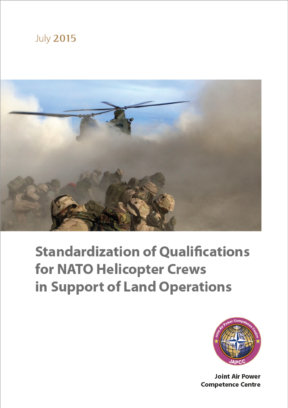Overview
The Joint Air Power Competence Centre (JAPCC) conducted a study in 2012 examining the vertical lift capability of the majority of European NATO member states. The Study1 identified deficiencies and shortcomings and offered possible solutions to overcome the identified challenges and improve this important capability. The findings of this study have been introduced to a variety of audiences and discussed through several activities. Some of the identified shortcomings and problem areas were addressed by other NATO activities and JAPCC projects (such as the Multinational Air Training Centre, Air Advisor Project2, etc.). However, problems related to standardization of qualifications issues across the vertical lift community are still to be resolved.
As a result of a recommendation in the Study, the NATO Helicopter Inter Service Working Group (HISWG) was tasked by the Military Committee Land Standardization Board (MCLSB) to develop a standardization document3 to specify the current operational readiness level of helicopter crews or units. This document will be referred to as ATP-90, with Germany designated as the custodian. The document will seek to provide NATO commanders in multinational operations or training events with better knowledge on the helicopter force readiness and the skill and proficiency levels they possess. This in turn, will aid them when making operational and tactical decisions.
This white paper provides information regarding qualification standardization for NATO crews in support of land operations which could improve interoperability and increase effectiveness of NATO helicopter operations. The use of a NATO qualification standard will enhance NATO commanders’ knowledge and understanding of the capabilities of assigned helicopter crews, improve understanding of individual competencies, optimize interoperability and facilitate multinational helicopter force operations.











